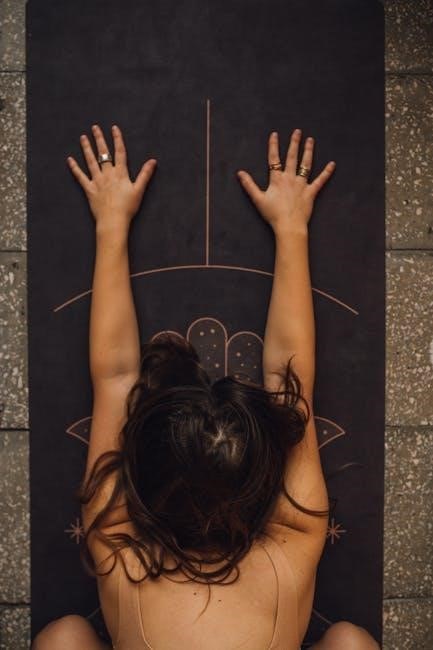Sciatica stretching exercises offer a non-invasive approach to alleviate pain by targeting tight muscles like the piriformis and hamstrings. These exercises improve flexibility, reduce discomfort, and promote healing. A downloadable sciatica stretches PDF guide provides easy access to effective routines, helping you manage symptoms and enhance mobility from home. Regular practice, combined with proper posture and hydration, can significantly reduce sciatic nerve irritation and improve overall well-being. Professional recommendations emphasize consistency and gentle movements to avoid exacerbating symptoms, making stretching a cornerstone of sciatica relief.
Understanding Sciatica and Its Causes
Sciatica refers to pain that radiates along the sciatic nerve, which extends from the lower back through the hips and down the legs. It is often caused by a herniated disk, piriformis syndrome, spinal stenosis, or spondylolisthesis. Symptoms include shooting pain, tingling, numbness, or weakness in the affected areas. Sciatica is not a medical condition itself but a symptom of an underlying issue. Identifying the root cause is crucial for effective treatment. Common triggers include poor posture, prolonged sitting, or repetitive strain. Understanding these factors helps in developing targeted strategies for relief and prevention.
Why Stretching Exercises Are Effective for Sciatica Relief
Stretching exercises are effective for sciatica relief as they target tight muscles, such as the piriformis and hamstrings, which often compress the sciatic nerve. These exercises improve flexibility, reduce muscle tension, and promote blood flow, helping to alleviate pain and discomfort. By addressing the root causes of sciatica, stretching can prevent future episodes and enhance overall mobility. Consistent practice, combined with proper posture and hydration, strengthens the musculature around the spine, providing long-term relief and improving quality of life for those suffering from sciatica symptoms.

Benefits of Stretching Exercises for Sciatica
Stretching exercises reduce sciatica pain, enhance mobility, and improve flexibility. They alleviate muscle tension, promote healing, and prevent future episodes, offering a natural, effective solution for long-term relief.
Pain Relief and Reduced Discomfort
Stretching exercises are highly effective in reducing sciatica-related pain by targeting tight muscles. Gentle stretches for the piriformis and hamstrings alleviate pressure on the sciatic nerve, providing immediate relief. Regular practice enhances blood flow, relaxes tense muscles, and reduces inflammation. This non-invasive approach helps diminish discomfort, allowing for improved daily activities. Consistency is key to achieving lasting pain reduction and preventing flare-ups. Incorporating exercises like knee-to-chest stretches and seated glute stretches can significantly ease sciatic nerve irritation, offering a natural solution for managing pain effectively.
Improved Mobility and Flexibility
Stretching exercises for sciatica significantly enhance mobility and flexibility by addressing tight muscles and improving joint movement. Targeting the hamstrings, hip flexors, and piriformis muscles helps restore range of motion, making everyday activities easier. Gentle stretches, such as the standing hamstring stretch or lying deep glute stretch, promote muscle relaxation and reduce stiffness. Regular practice not only improves flexibility but also prevents muscle imbalances that contribute to sciatica. Enhanced mobility enables individuals to move comfortably, supporting overall physical function and reducing the risk of further discomfort.
Sciatic Nerve Glide and Decompression
Sciatic nerve glide and decompression exercises are designed to reduce pressure on the sciatic nerve, alleviating pain and discomfort. These exercises involve gentle movements that promote nerve mobility, such as lying on your back and slowly moving your knees from side to side. Regular practice helps improve nerve function and reduce irritation caused by compression. By incorporating exercises like the knee-to-chest stretch and spinal decompression techniques, individuals can experience significant relief from sciatica symptoms. Consistency in these exercises is key to maintaining nerve health and preventing future episodes of pain.
Relief from Muscle Tension
Stretching exercises for sciatica are highly effective in relieving muscle tension, particularly in the piriformis, hamstrings, and hip flexors. Tight muscles can compress the sciatic nerve, worsening symptoms. Gentle stretches like the piriformis stretch and seated glute stretch help relax these muscles, reducing nerve irritation. By targeting specific muscle groups, individuals can alleviate tightness and discomfort, promoting a healthier range of motion. Regular stretching also improves circulation, further enhancing muscle relaxation and overall comfort. This makes muscle tension relief a crucial benefit of incorporating stretching exercises into a sciatica management routine.
Prevention of Future Episodes
Consistent stretching exercises play a vital role in preventing future sciatica episodes by maintaining muscle flexibility and strength. Regular routines, such as piriformis and hamstring stretches, help reduce muscle imbalances that can lead to nerve compression. Strengthening core muscles also improves spinal stability, lowering the risk of recurrence. Additionally, proper posture and movement techniques, guided by resources like the sciatica stretches PDF, ensure long-term relief. By addressing the root causes of sciatica, these exercises create a sustainable path to preventing future flare-ups and maintaining overall lower back health.

Essential Tips for Performing Sciatica Stretches
Stay hydrated to enhance muscle function, maintain proper posture to prevent strain, and avoid activities that worsen pain. Consistency in your routine ensures effective relief.
Stay Hydrated for Optimal Muscle Function
Proper hydration is crucial for muscle elasticity and blood flow, essential for effective sciatica stretches; Water helps maintain tissue health and reduces muscle cramping during exercises. Drinking water before and after stretching ensures muscles function optimally, minimizing discomfort. Dehydration can lead to stiffness, worsening sciatica symptoms. Staying hydrated supports the body’s natural healing processes and enhances the benefits of stretching exercises, promoting long-term relief from sciatic nerve irritation. Incorporate hydration reminders, like sipping water every 30 minutes, to maintain consistency and maximize the effectiveness of your routine.
Maintain Proper Posture During Exercises
Maintaining proper posture during stretching exercises is vital for effective sciatica relief. Poor posture can exacerbate sciatic nerve irritation, reducing the benefits of stretches. Stand or sit tall, keeping your spine aligned to avoid unnecessary pressure on the lower back. During seated exercises, ensure your feet are flat on the floor and knees at hip level. For standing stretches, keep weight evenly distributed and engage your core for stability. Proper posture ensures targeted muscles are stretched effectively, enhancing pain relief and improving overall results. Consistent posture habits support long-term healing and prevent future episodes of sciatica discomfort.
Avoid Activities That Exacerbate Pain
Certain activities can worsen sciatica symptoms, so identifying and avoiding them is crucial for effective relief. Heavy lifting, repetitive twisting, and prolonged sitting or standing can increase pressure on the sciatic nerve. High-impact exercises, such as running or jumping, may also aggravate discomfort. Avoiding these activities helps reduce irritation and allows the nerve to heal. Instead, opt for low-impact movements like swimming or cycling, which promote mobility without strain. By eliminating pain-triggering activities, you create a more conducive environment for recovery and long-term sciatica management. Always consult a healthcare professional to tailor your activity plan.
Incorporate Consistency in Your Routine
Consistency is key to achieving lasting relief from sciatica symptoms. Performing stretching exercises daily, even for short periods, helps maintain muscle flexibility and reduces nerve pressure. Aim for gentle stretches, such as knee-to-chest or seated glute stretches, to target tight areas without overexertion. Tracking your progress and adjusting routines as needed ensures sustained improvement. Over time, regular practice strengthens supporting muscles and enhances mobility, making it easier to manage sciatica effectively. Remember, consistency is more important than intensity when it comes to long-term relief. Always consult a professional to tailor your routine for optimal results.

Recommended Stretching Exercises for Sciatica
Gentle stretches like the piriformis stretch, lying glute stretch, and seated hamstring stretch are highly effective for sciatica relief. These exercises target tight muscles and improve flexibility. A downloadable sciatica stretches PDF guide offers easy access to these routines, helping you manage symptoms and strengthen supporting muscles for long-term comfort. Regular practice promotes healing and reduces nerve pressure, ensuring sustained relief from sciatica pain.
Gentle Stretches for Sciatica Relief
Gentle stretches are essential for alleviating sciatica pain without causing further strain. Exercises like the piriformis stretch, seated hamstring stretch, and lying glute stretch target tight muscles that irritate the sciatic nerve. These movements improve flexibility and reduce discomfort. Perform stretches slowly, holding each for 20-30 seconds to maximize relief. A comprehensive sciatica stretches PDF guide provides detailed instructions for these exercises, ensuring proper form and safety. Regular practice helps decompress the sciatic nerve, promoting healing and reducing inflammation for lasting comfort and mobility.
Intermediate Exercises for Sciatica Management
Intermediate exercises build on gentle stretches, incorporating movements that strengthen and stabilize the lower back and hips. The cat-cow stretch and bird dog exercise improve spinal flexibility and core strength, while spinal decompression exercises relieve pressure on the sciatic nerve. These exercises are more dynamic than gentle stretches but still prioritize comfort and proper form. A sciatica stretches PDF guide often includes step-by-step instructions for these exercises, ensuring progression at a safe and effective pace. Regular practice helps strengthen supportive muscles, reducing sciatica flare-ups and enhancing overall mobility and stability.
Advanced Stretches for Sciatica Prevention
Advanced stretches are designed to enhance strength and flexibility while preventing recurring sciatica episodes. Exercises like the standing hamstring stretch and side-lying clam target the glutes and hamstrings, improving muscle balance. The prone knee flexion stretch focuses on relieving tension in the lower back and hips. These stretches are more intense than intermediate exercises but are still low-impact, ensuring safety and effectiveness. A comprehensive sciatica stretches PDF guide typically includes detailed instructions for these advanced movements, helping you maintain long-term relief and prevent future flare-ups with consistent practice.

Exercises to Avoid If You Have Sciatica
Avoid heavy lifting, twisting movements, and high-impact activities like running, as they can worsen sciatica symptoms. Specific core exercises that exacerbate pain should also be avoided. Consult a professional for guidance.
Heavy Lifting and Twisting Movements
Heavy lifting and twisting movements can exacerbate sciatica symptoms by placing additional stress on the lower back and sciatic nerve. These actions can worsen inflammation and irritation, leading to increased pain. It’s crucial to avoid lifting heavy objects without proper support or technique. Twisting movements, especially when combined with lifting, can further strain the spine and nerves. Instead, focus on gentle stretches and exercises that promote healing without aggravating the condition. Always prioritize proper lifting techniques or seek assistance to prevent further discomfort and support recovery. This approach ensures safer management of sciatica symptoms and reduces the risk of complications.

High-Impact Activities
High-impact activities, such as running, jumping, or repetitive landing, can exacerbate sciatica symptoms by placing repetitive stress on the spine and sciatic nerve. These movements can cause shockwaves that irritate the nerve, worsening pain and discomfort. Activities like jogging or aerobics, which involve heavy foot striking, should be avoided until symptoms improve. Instead, opt for low-impact exercises like swimming or cycling, which are gentler on the spine and nerves. Avoiding high-impact movements is essential to prevent further irritation and allow the sciatic nerve to heal. This helps in managing pain and promoting long-term recovery.
Specific Core Exercises That Worsen Symptoms
Certain core exercises, such as heavy lifting, twisting movements, and some yoga poses like Boat Pose, can worsen sciatica symptoms. These activities may compress the sciatic nerve or strain the lower back muscles, leading to increased pain and discomfort. Avoid exercises that involve repetitive bending, heavy weights, or direct pressure on the spine. Planks and crunches can also exacerbate symptoms if proper form is not maintained. Instead, focus on gentle stretches and low-impact activities to protect the sciatic nerve and promote healing. Always consult a professional to tailor exercises to your condition.

Yoga and Pilates for Sciatica Relief
Yoga and Pilates offer gentle, effective exercises to stretch tight muscles and strengthen the core, reducing sciatic nerve pressure and promoting long-term relief from discomfort.
Beneficial Yoga Poses for Sciatica
Yoga poses like Child’s Pose, Cat-Cow, and Pigeon Pose are highly effective for sciatica relief. These exercises gently stretch the hips, hamstrings, and lower back, reducing pressure on the sciatic nerve. Child’s Pose elongates the spine, while Pigeon Pose targets the piriformis muscle, often a source of sciatica pain. Regular practice improves flexibility and strengthens core muscles, enhancing posture and reducing discomfort. These poses are low-impact and can be modified to suit different fitness levels, making them ideal for managing sciatica symptoms. Download your sciatica stretches PDF for detailed guidance on these exercises.
Pilates Exercises for Sciatica Management
Pilates exercises, such as the Pelvic Tilt and Knee Folds, are excellent for sciatica management. These movements strengthen the core and improve spinal alignment, reducing pressure on the sciatic nerve. Gentle stretches like the Spine Stretch and Hamstring Stretch further alleviate tightness in the lower back and legs. Pilates focuses on controlled movements, enhancing posture and stability. Regular practice can help prevent future episodes by strengthening the muscles that support the spine. Incorporate these exercises into your routine for long-term relief and improved mobility. Download your sciatica stretches PDF for a comprehensive guide to these exercises.

Lifestyle Modifications for Sciatica Relief
Adopting regular movement, maintaining a healthy weight, and ensuring proper sleep posture can significantly alleviate sciatica symptoms. Ergonomic adjustments at work and home also play a crucial role in preventing discomfort and promoting long-term relief. Incorporate these lifestyle changes alongside stretching exercises for optimal results, as outlined in your sciatica stretches PDF guide.
Regular Movement and Activity
Engaging in regular movement is essential for sciatica relief, as it helps maintain mobility and prevents muscle stiffness. Activities like walking, swimming, and gentle stretching can improve circulation and reduce pressure on the sciatic nerve. Avoid prolonged sitting or standing, as this can exacerbate symptoms. Incorporate short, frequent breaks into your day to stretch and move, especially if your job involves sitting for long periods. Gentle exercises, such as yoga or light cardio, can also strengthen core muscles and improve posture, further alleviating sciatica discomfort. Consistency is key to long-term relief.
Ergonomic Adjustments at Work
Ergonomic adjustments at work are crucial for preventing sciatica flare-ups. Ensure your chair height and desk position promote proper posture, with feet flat on the floor or a footrest. Position your computer monitor at eye level to avoid neck strain. Take regular breaks every 30-60 minutes to stand, stretch, and move around. Avoid prolonged sitting or repetitive tasks that can irritate the sciatic nerve; Consider using an ergonomic keyboard and mouse to reduce strain on your lower back. A well-organized workspace can significantly reduce discomfort and support long-term sciatica relief.
Weight Management
Maintaining a healthy weight is essential for sciatica relief, as excess weight can strain the lower back and sciatic nerve. A balanced diet combined with regular exercise helps manage weight and reduces pressure on the spine. Even a modest weight loss can alleviate sciatica symptoms by decreasing inflammation and muscle strain. Avoiding extra pounds prevents unnecessary stress on the sciatic nerve, promoting long-term comfort and mobility. Incorporating stretching exercises into your routine further enhances the benefits of weight management for sciatica relief.

Proper Sleep Posture

Maintaining proper sleep posture is crucial for managing sciatica symptoms. Use a supportive mattress and consider placing a pillow between your knees to reduce pressure on the sciatic nerve. Avoid sleeping on your stomach, as it can strain your lower back. Side sleeping with a pillow under your legs or using a body pillow can help maintain spinal alignment. A neutral spine position during sleep prevents nerve irritation. Incorporating these adjustments can enhance the benefits of stretching exercises and promote better recovery from sciatica-related discomfort.
Empower yourself with stretching exercises for sciatica relief. Download your free sciatica stretches PDF guide for a comprehensive, easy-to-follow plan to alleviate pain and improve mobility.
Final Thoughts on Sciatica Relief
Consistency and patience are key to managing sciatica through stretching exercises. These routines, outlined in your sciatica stretches PDF guide, target tight muscles and improve mobility. Regular practice can significantly reduce discomfort and prevent future episodes. While stretching is highly effective, it’s important to complement it with proper posture, hydration, and lifestyle adjustments. For severe cases, consult a healthcare professional to tailor your approach. Embrace these exercises as a long-term solution for relief and enhanced well-being. Take the first step toward a pain-free life with your comprehensive guide today!
Download Your Free Sciatica Stretches PDF Guide
Your journey to sciatica relief begins with our free Sciatica Stretches PDF Guide. Packed with detailed exercises and tips, this guide offers easy-to-follow routines to alleviate pain and improve mobility. From gentle stretches to advanced movements, it covers everything needed for effective sciatica management. Perfect for home use, the guide ensures you can practice safely and consistently. Download now and start your path toward a pain-free life with exercises tailored to your needs. Take control of your sciatica symptoms today with this essential resource!

